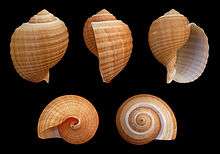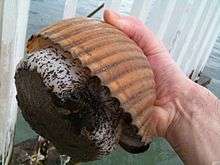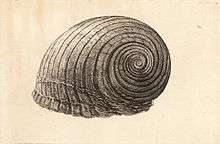Tonna galea
| Giant tun | |
|---|---|
 | |
| Five views of a shell of Tonna galea | |
 | |
| A live giant tun, from Greece | |
| Scientific classification | |
| Kingdom: | Animalia |
| Phylum: | Mollusca |
| Class: | Gastropoda |
| (unranked): | clade Caenogastropoda clade Hypsogastropoda clade Littorinimorpha |
| Superfamily: | Tonnoidea |
| Family: | Tonnidae |
| Genus: | Tonna |
| Species: | T. galea |
| Binomial name | |
| Tonna galea (Linnaeus, 1758) | |
| Synonyms | |
|
See List of synonyms | |
Tonna galea, commonly known as the giant tun, is a species of marine gastropod mollusc in the family Tonnidae (also known as the tun shells). This very large sea snail or tun snail is found in the North Atlantic Ocean as far as the coast of West Africa, in the Mediterranean Sea and the Caribbean Sea. The species was first described by Carl Linnaeus in 1758.[1]
Description


The ventricose shell of adult Tonna galea is very large, with an average height of 6 inches (150 mm).[2][3] Specimens of this species have been quoted of the size of a man's head. The shell is thin and inflated,[2][3] but still relatively solid and durable.[3] The shell is almost diaphanous when young; at that time the transverse ribs of the surface are only indicated by lines of a slightly deeper tint. In terms of its weight however, the thin shell is very much lighter than the shell of most other large sea snails.[4] The aperture of the shell is "distinctly round" and wide.[4]
The conical spire is formed of six convex, very distinct whorls, loaded externally with wide, flat, slightly raised ribs, separated by narrow and superficial furrows. The whorls of the spire are isolated by a deep channeled suture. The body whorl is rounded and very ventricose. The aperture is large, subovate, colored interiorly with reddish, and marked with transverse ribs corresponding to the furrows without. The outer lip is dilated, undulated, tinged with black, or a deep brown upon the edge. The inner lip is whitish, spread out in a very thin plate upon the belly of the body whorl. The columella is smooth, polished, and forms at the left of the umbilicus a thick rib, marked by transverse striae, which terminates at the emargination of the base. The external surface of this shell is of an uniform reddish fawn color ; nevertheless the ribs are varied with wide spots or irregular brown and white blotches which are very remarkable.[5]
The animal is of a clear brownish red, without spots, and its tentacles are encircled, towards the point, with a wide reddish-brown ring. The foot beneath is of a dark violet, with the edge embroidered with deep brown.[5] Tonna galea possess large salivary glands. The structure of these glands was first described and detailed by Heinrich Weber in 1927.[6] Furthermore, the Giant Tun is also a luminescent species; this is an extremely rare characteristic among the prosobranch gastropods. The animal gives off light that is green-white in colour when it traverses through the water with its foot "well-extended".[7]
Distribution and habitat
This large sea snail is found in the North Atlantic Ocean (specifically the Canary Islands and Madeira), the Mediterranean Sea, the Caribbean Sea, and in the waters off the coast of Angola, Cape Verde and West Africa.[1] The preferred habitat for this species is seabeds that are muddy or sandy with seagrass beds. In the Mediterranean, these snails are typically found at depths ranging from just beneath the surface to 120 metres (390 ft).[8]
Tonna galea has been placed on Annex II of both the Berne Convention on the Conservation of European Wildlife and Natural Habitats and the Protocol of the Barcelona Convention for Protection against Pollution in the Mediterranean Sea.[8][9] In spite these designations, it continues to be "exploited".[8]
Ecology
Information on the biology and life history of Tonna galea is scarce, due to the fact that the species has only rarely been studied.[8] It is carnivorous,[10] and utilizes its two proboscises—located on top of its head[10]—to envelop its prey, which primarily consists of sea cucumbers.[11] To a lesser extent it also feeds on sea urchins, starfish.[12] fish, bivalves and crustaceans.[10] As a defense mechanism, the snail will squirt its highly-acidic saliva when disturbed.[6] This contains approximately 2–5% sulfuric acid, which is used to kill its prey.[12] The presence of this acid was recorded by Franz Hermann Troschel in 1854.[6]
List of synonyms
This is a list of all the various scientific names that have been applied to this species over time.
- Buccinum galea Linnaeus, 1758 (original combination)
- Buccinum olearium Linnaeus, 1758
- Cadium galea (Linnaeus, 1758)
- Cadus galea (Linnaeus, 1758)
- Dolium (Dolium) galea (Linnaeus, 1758)
- Dolium (Dolium) galea antillarum (Mörch, 1877)
- Dolium (Dolium) galea var. brasiliana (Mörch, 1877)
- Dolium (Dolium) galea var. epidermata (de Gregorio, 1884)
- Dolium (Dolium) galea var. spirintrorsum (de Gregorio, 1884)
- Dolium (Dolium) galea var. tardina (de Gregorio, 1884)
- Dolium antillarum Mörch, 1877
- Dolium antillarum var. brasiliana Mörch, 1877
- Dolium epidermata de Gregorio, 1884
- Dolium galea (Linnaeus, 1758)
- Dolium galea var. epidermata de Gregorio, 1884
- Dolium galea var. spirintrorsa de Gregorio, 1884
- Dolium galea var. spirintrorsum de Gregorio, 1884
- Dolium galea var. tardina de Gregorio, 1884
- Dolium galeatum Locard, 1886
- † Dolium modjokasriense Martin, 1899
- Dolium tardina de Gregorio, 1884
- Dolium tenue Menke, 1830
- Tonna (Tonna) galea (Linnaeus, 1758)
- Tonna (Tonna) galea brasiliana (Mörch, 1877)
- Tonna (Tonna) galea galea (Linnaeus, 1758)
- Tonna galea abbotti Macsotay & Campos, 2001
- Tonna galea brasiliana (Mörch, 1877)
- Tonna olearium (Linnaeus, 1758)
References
- 1 2 Gofas, Serge; Vandepitte, Leen; Vos, Chris (2011). "Tonna galea (Linnaeus, 1758)". World Register of Marine Species. Flanders Marine Institute. Retrieved February 18, 2014.
- 1 2 Kaplan, Eugene H. (1999). A Field Guide to Southeastern and Caribbean Seashores: Cape Hatteras to the Gulf Coast, Florida, and the Caribbean. Houghton Mifflin Harcourt. p. 240. Retrieved February 12, 2014.
- 1 2 3 Morris, Percy A. (2001). A Field Guide to Shells: Atlantic and Gulf Coasts and the West Indies. Houghton Mifflin Harcourt. p. 206. Retrieved February 12, 2014.
- 1 2 Bertini, Giovana; Fransozo, Adilson (2000). "Patterns of Shell Utilization in Petrochirus diogenes (Decapoda, Anomura, Diogenidae) in the Ubatuba Region, São Paulo, Brazil". Journal of Crustacean Biology. The Crustacean Society. 20 (3): 468–473. doi:10.1163/20021975-99990061. Retrieved January 17, 2014. (subscription required)
- 1 2 Kiener (1840). General species and iconography of recent shells : comprising the Massena Museum, the collection of Lamarck, the collection of the Museum of Natural History, and the recent discoveries of travellers; Boston :W.D. Ticknor,1837 (described as 'Dolium olearium)
- 1 2 3 Houbrick, Joseph R.; Fretter, Vera (1969). "Some Aspects of the Functional Anatomy and Biology of Cymatium and Bursa" (PDF). Journal of Molluscan Studies. Oxford University Press on behalf of The Malacological Society of London. 38 (5): 415–429. Retrieved January 17, 2014. (subscription required)
- ↑ Haneda, Y. (April 1958). "Studies on Luminescence in Marine Snails" (PDF). Pacific Science. University of Hawai'i Press. 12 (2): 152–156. ISSN 0030-8870. Retrieved February 14, 2014.
- 1 2 3 4 Doxa, Chrisa K.; Sterioti, Aspasia; Kentouri, Maroudio; Divanach, Pascal (2011). "Encapsulated development of the marine gastropod Tonna galea (Linnaeus, 1758) in captivity" (PDF). Journal of Biological Research. Academic Search Complete. 16: 304–307. Retrieved February 13, 2014. (subscription required)
- ↑ Cuttelod, Annabelle; Seddon, Mary; Neubert, Eike (2011). "European Red List of Non-marine Molluscs" (PDF). European Commission. Publications Office of the European Union. Retrieved February 13, 2014.
- 1 2 3 Morton, Brian (1969). "Aspects of Predation by Tonna zonatum (Prosobranchia: Tonnoidea) Feeding On Holothurians in Hong Kong" (PDF). Journal of Molluscan Studies. Oxford University Press on behalf of The Malacological Society of London. 57 (1): 11–19. doi:10.1093/mollus/57.1.11. Retrieved February 17, 2014. (subscription required)
- ↑ Toscano, A.; Bentivegna, F.; Cirino, P. (June 1, 1992). "Holothurians' responses to attack by the tonnid gastropod Tonna galea". In Scalera-Liaci, L. Echinoderm Research 1991. CRC Press. p. 204. Retrieved February 15, 2014.
- 1 2 Alyakrinskaya, I. O. (2002). "Morphofunctional Properties of Nutrition of Certain Predatory Gastropods" (PDF). Biology Bulletin of the Russian Academy of Sciences. Springer Publishing. 29 (6): 589–600. Retrieved February 15, 2014.
External links
| Wikimedia Commons has media related to Tonna galea. |
| Wikispecies has information related to: Tonna galea |
- Penchaszadeh, Pablo E. (1981). "A peculiar developmental pattern in Tonna galea (Mollusca, Prosobranchiata) from Venezuela". International Journal of Invertebrate Reproduction. Elsevier/North-Holland Biomedical Press. 4 (3): 209–212. doi:10.1080/01651269.1981.10553429. (subscription required)